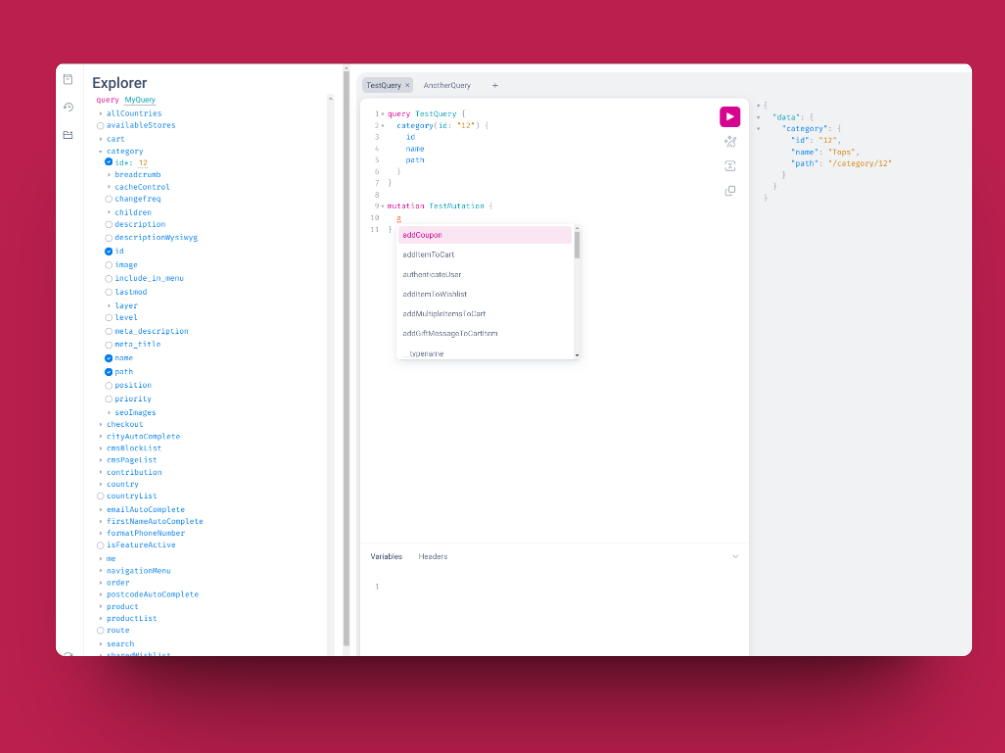GraphQL over HTTP
Your application's unified GraphQL schema can be exposed over HTTP in production or for development purposes only. This guide explains the different options and patterns available to expose a GraphQL HTTP endpoint.
The /graphql route
By default, Front-Commerce exposes a GraphQL HTTP endpoint on the /graphql
URL. This endpoint is available in production and development environments.
It uses GraphQL Yoga under the
hood, and is configured to use the same unified GraphQL schema as
the one used across the application (via app.graphql).
You can use this endpoint to query your application's GraphQL API from your frontend or from any other application.
GraphQL Playground
In development mode, Front-Commerce exposes a
GraphiQL Playground on the
/graphql route. This UI allows you to explore
your application's GraphQL API using a Documentation Explorer, and to test
queries and mutations without any additional tool.
Production mode
Several GraphQL DX features are disabled in production mode, in order to improve performance and security:
- GraphiQL Playground
- GraphQL introspection
- GraphQL fields suggestions
By production mode, we mean that the FRONT_COMMERCE_ENV environment variable
is set to production. This is what we recommend for production sites (but not
needed for staging or local environments).
How-to customize the HTTP GraphQL endpoint
You may want to customize how the GraphQL endpoint is exposed over HTTP. For example, you may want to expose it for logged in users only, to disable it or to expose it on a different route. This section explains some of the options available to you.
Expose the GraphQL endpoint on a different route
The default /graphql route is registered by the @front-commerce/remix
package. You can reuse its loader/action in another route to expose the GraphQL
endpoint on a different URL as well.
You will then import the default loader and action from the
@front-commerce/remix/playground.server package export. A minimal route
exposing the GraphQL endpoint on the /my-other-endpoint would look like this:
export { loader, action } from "@front-commerce/remix/playground.server";
To stop exposing the GraphQL endpoint on the default /graphql route, you can
follow the next section.
Override the GraphQL /graphql endpoint
One of the most common use case you may have is to customize the default
/graphql endpoint for disabling it or for exposing it only for logged in users
for example.
Override the default /graphql endpoint by creating a new route with the same
path in your application. You can then import the default loader and action as
illustrated in the previous section.
For example, if you want to expose the GraphQL endpoint only for logged in users, you can create a new route like this:
import { FrontCommerceApp } from "@front-commerce/remix";
import {
loader as defaultLoader,
action as defaultAction,
} from "@front-commerce/remix/playground.server";
import type { ActionFunction, LoaderFunction } from "@remix-run/node";
import { MagentoUserService } from "@front-commerce/magento2/user";
import type { User } from "@front-commerce/core/graphql";
import { json } from "@front-commerce/remix/node";
const guardAgainstLoggedOutUser = (user: User) => {
const magentoUser = MagentoUserService.createUser(user);
if (!magentoUser.isLoggedIn) {
throw json(
{ errors: [{ message: "Feature not enabled" }] },
{
status: 403,
}
);
}
};
export const loader: LoaderFunction = async (args) => {
const app = new FrontCommerceApp(args.context.frontCommerce);
guardAgainstLoggedOutUser(app.user);
return defaultLoader(args);
};
export const action: ActionFunction = async (args) => {
const app = new FrontCommerceApp(args.context.frontCommerce);
guardAgainstLoggedOutUser(app.user);
return defaultAction(args);
};
In conclusion, the logic of the default loader and action is reused in your custom route, and you can any of your own logic before calling them.
